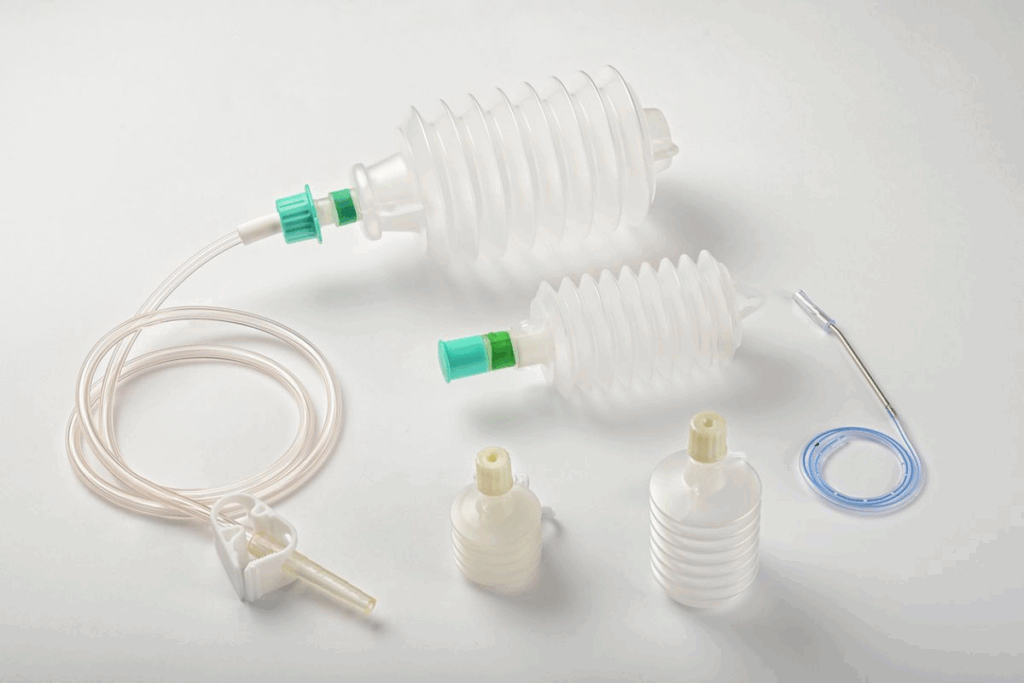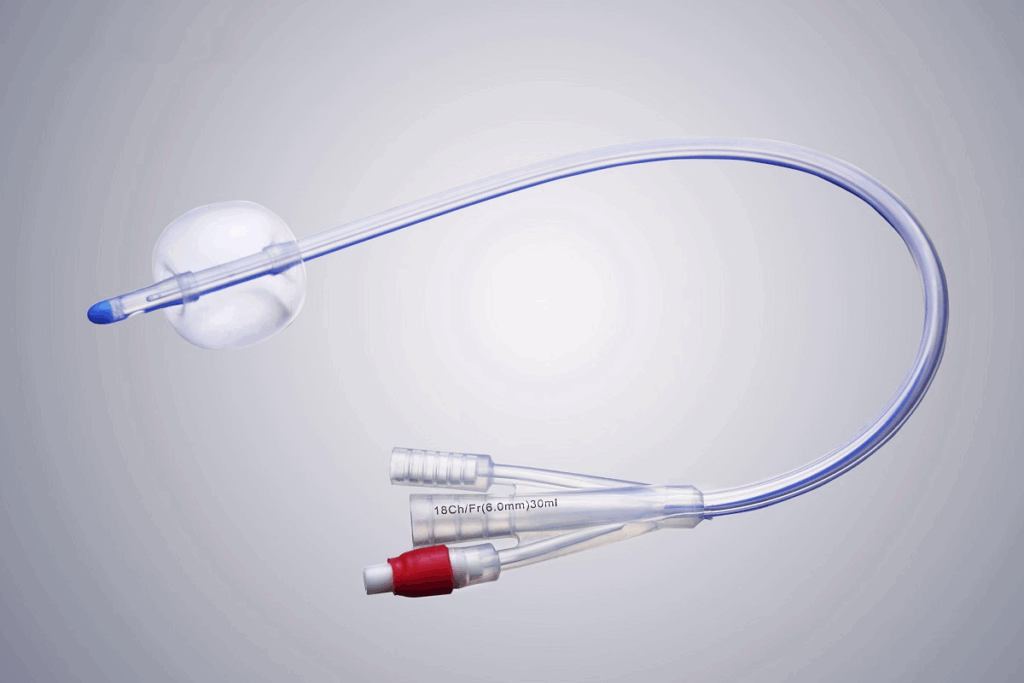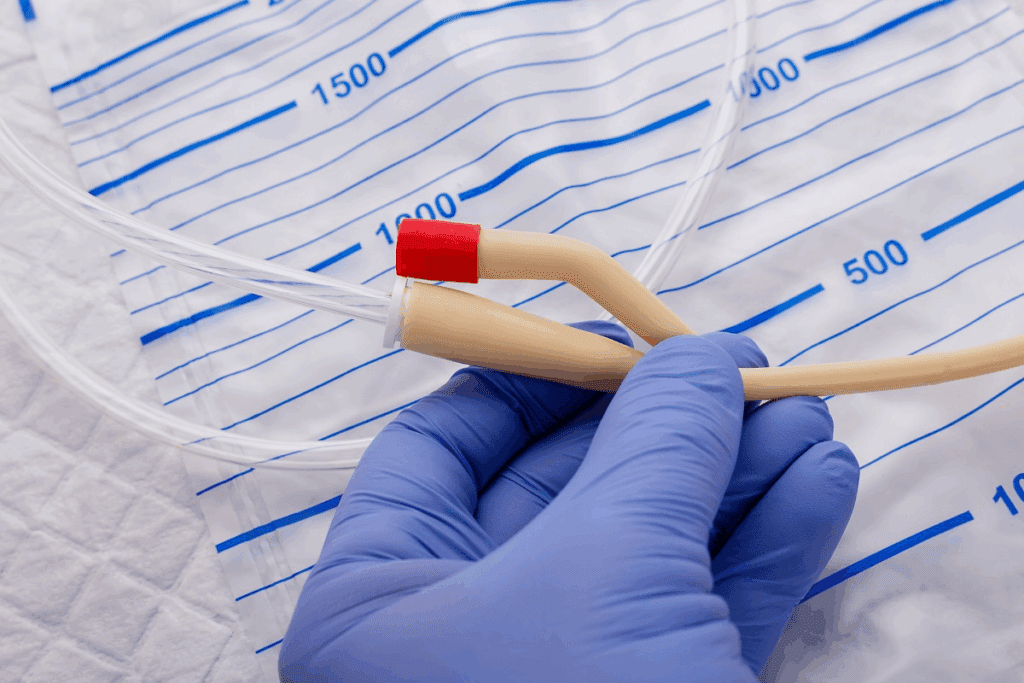Last Updated on November 26, 2025 by Bilal Hasdemir

Caring for a biliary drainage catheter is key for those with liver or bile duct issues. This device helps clear blockages and supports liver health. So, it’s important to care for it well for a smooth recovery.
At Liv Hospital, we focus on you when it comes to your biliary drain catheter. Our guide covers daily care and fixes, helping you manage your device. This way, you can keep your catheter working well for longer.
By using our easy steps, you can avoid problems and stay comfortable. This lets you focus on getting better and feeling good again.
Key Takeaways
- Understand the importance of proper biliary catheter care for optimal recovery.
- Learn daily maintenance tips to keep your catheter secure and effective.
- Discover troubleshooting techniques to address common issues.
- Explore Liv Hospital’s patient-centered approach to biliary drain management.
- Maximize your comfort and minimize complications with our expert guidance.
Understanding Your Biliary Drainage Catheter

Getting to know your biliary drainage catheter is key to managing your health. A biliary catheter is a tube that helps bile flow from your liver when it can’t on its own.
What is a Biliary Drainage Catheter?
A biliary drainage catheter, or bile catheter, is a medical tool. It’s put into your body to drain bile from your liver or bile ducts. It helps when blockages, like gallstones or tumors, stop bile from flowing right.
Types of Biliary Drains
There are various biliary drains out there. You’ve got internal-external drains and external drains. Internal-external drains let bile flow both inside and outside your body. External drains send bile to a bag outside your body.
- Internal-external biliary drains
- External biliary drains
Why You Need a Biliary Catheter
You might need a biliary catheter if bile flow is blocked. This could be because of cancer, gallstones, or other liver or bile duct issues. The catheter helps by making sure bile drains properly, easing symptoms like jaundice and itching.
It’s important to understand the biliary duct drainage catheter you have. Your doctor will help you learn how to care for it and handle any problems that come up.
Essential Supplies for Biliary Catheter Care

To keep your biliary catheter working well, you need the right medical supplies. Taking good care of your liver drainage tube means using the right supplies and keeping things clean.
Medical Supplies Checklist
Having a list of medical supplies is key for daily care of your biliary drainage catheter. Here are the must-haves:
- Sterile gloves
- Antiseptic solutions (e.g., chlorhexidine)
- Dressing materials (gauze pads, transparent dressings)
- Medical tape
- Scissors (preferably sterile)
- Saline solution for flushing
- A syringe for flushing
- Drainage bags
Having these supplies ready will make caring for your biliary catheter easier.
Creating a Clean Workspace
Before you start any biliary catheter care, make sure your workspace is clean. This means:
- Clearing a flat surface
- Cleaning the surface with a disinfectant
- Letting it dry completely
- Organizing your supplies neatly
A clean workspace reduces infection risk and makes care safer.
Organizing Your Supplies
Keeping your medical supplies organized is important for biliary catheter care. Use a container or bag to store them all. Labeling your supplies helps you find what you need quickly.
| Supply | Purpose | Storage Tip |
| Sterile Gloves | Prevent infection during care | Keep in original packaging |
| Antiseptic Solution | Clean the catheter site | Store in a cool, dry place |
| Dressing Materials | Cover and protect the catheter site | Keep in a sealed container |
With the right supplies and a clean, organized workspace, you can take good care of your biliary drainage catheter.
Daily Cleaning and Maintenance Procedures
Keeping your biliary drainage catheter clean is key to avoiding infections and keeping it working right. We’ll show you how to take care of it every day.
Proper Hand Hygiene
Before you touch your biliary drain tube, make sure your hands are clean. Wash your hands well with soap and warm water for 20 seconds. If you can’t find soap and water, use an alcohol-based hand sanitizer.
Here’s how to clean your hands:
- Wet your hands with warm water.
- Use enough soap to cover your hands.
- Scrub all surfaces with your hands together.
- Rinse your hands well under running water.
- Dry your hands completely with a clean towel or air dryer.
Inspecting Your Biliary Drainage Catheter
It’s important to check your biliary drainage catheter often. Look for damage, kinking, or blockage. Make sure it’s in the right spot and the drainage bag works right.
If you see any problems, like leaks or blockages, call your doctor right away.
Cleaning the Insertion Site
Cleaning the spot where the catheter goes in is a big part of daily care. Use a sterile saline solution or an antiseptic your doctor suggests. Gently clean the area with a sterile gauze or cotton swab, starting from the center and moving out.
After cleaning, let the area air dry or gently pat it dry with a sterile gauze. This helps stop bacteria from growing and lowers the chance of infection.
By sticking to these daily cleaning and care steps, you can make sure your biliary drainage catheter lasts longer and works better.
How to Flush Your Biliary Drain Tube
Flushing your biliary drain tube is key to keeping it working right. It stops problems before they start. This makes sure bile from your liver goes into the drainage bag.
Preparing for the Flushing Procedure
Get ready to flush your biliary drain tube by setting up a clean area. You’ll need a sterile saline solution, a syringe, and sterile gloves. Make sure your workspace is clean and free from dirt.
Wash your hands well with soap and water. Then, put on your sterile gloves to avoid infection.
Step-by-Step Flushing Instructions
To flush your biliary drain tube, follow these steps:
- Draw the sterile saline solution into the syringe.
- Attach the syringe to the catheter hub.
- Gently flush the saline solution into the catheter.
- Check for any resistance or blockages.
- Repeat the flushing process as directed by your healthcare provider.
Frequency of Flushing
How often you flush your biliary drain tube depends on your health and the catheter type. Typically, flushing is done once or twice a day. Always follow what your healthcare provider says.
Flushing regularly keeps the catheter open and prevents clogs. This ensures bile flows freely from your liver.
Changing and Managing Your Drainage Bag
Managing your drainage bag well is key to keeping your bile duct catheter healthy. It’s important to know when and how to empty it, replace it when needed, and watch the output.
When to Empty the Drainage Bag
Empty your drainage bag when it’s half full to avoid overflow and leakage. How often you need to empty it depends on your output. This can change based on your health and how active you are.
How to Properly Empty the Bag
To empty your drainage bag, follow these steps:
- Wash your hands before handling the bag.
- Open the drainage valve or stopcock.
- Empty the contents into a toilet or a measuring container if you need to track output.
- Close the valve securely to prevent leakage.
Replacing the Drainage Bag
Replace the drainage bag as the manufacturer says or as your healthcare provider advises. This is usually every 1-2 weeks. To replace the bag:
- Prepare the new bag by ensuring it’s properly connected to the catheter.
- Close the stopcock on the new bag.
- Disconnect the old bag from the catheter, taking care not to touch the catheter tip.
- Attach the new bag securely.
Monitoring Drainage Output
It’s important to watch the output from your drainage bag. This helps check if your biliary drainage catheter is working right. Keep track of how much and what the output looks like. If you notice big changes, like more or less output, or if the color or consistency changes, tell your healthcare provider.
| Output Characteristic | Normal Range | Action if Abnormal |
| Volume | Varies by individual | Notify healthcare provider if significantly increased or decreased |
| Color | Greenish-brown (bile) | Report if clear, dark, or contains blood |
| Consistency | Thin, watery | Notify if thick or contains debris |
By following these guidelines, you can manage your drainage bag well. This helps with the success of your biliary drainage catheter care.
Dressing Change Procedures for Biliary Catheter Drainage
Changing your biliary catheter dressing is key to keeping your skin healthy. We’ll show you how to do it right, focusing on keeping everything clean to avoid infections.
Frequency of Dressing Changes
How often you need to change your dressing depends on your doctor’s advice and your catheter site’s condition. Usually, you should change it every 2-3 days. But, if the dressing gets wet, dirty, or falls off, you’ll need to change it sooner.
Always follow your doctor’s advice on how often to change your dressing. They might tell you to do it more often if needed.
Removing the Old Dressing
When you take off the old dressing, be gentle to avoid hurting your skin or the catheter.
- Wash your hands well before starting.
- Start peeling off the dressing from one edge and move around the catheter site.
- If it sticks, use sterile saline solution to help remove it.
Applying a New Sterile Dressing
Putting on a new dressing is important to keep your site clean and safe.
- Clean the area with an antiseptic solution, moving from the center outwards.
- Let it dry completely before putting on a new dressing.
- Use a sterile gauze pad or dressing made for catheter sites.
- Secure it with medical tape, but not too tight.
Here’s a quick guide to the dressing change process:
| Step | Description | Notes |
| 1 | Wash hands | Use soap and water or hand sanitizer |
| 2 | Remove old dressing | Gently peel off; moisten if necessary |
| 3 | Clean the site | Use antiseptic solution; let it dry |
| 4 | Apply new dressing | Use sterile gauze or dressing |
By following these steps and keeping everything clean, you can lower the risk of infection. This helps your biliary catheter last longer.
Managing Daily Activities with a Liver Drainage Tube
Living with a biliary drainage catheter can be tough, but it’s doable. We know adjusting to life with a medical device takes time. We’re here to help you every step of the way.
Bathing and Showering Guidelines
When you bathe or shower with a liver drain tube, be careful. Cover the catheter site with a waterproof dressing or bag. Also, don’t soak the catheter in water without talking to your doctor first.
Clothing Considerations
Wearing the right clothes can help you feel better with a liver drainage tube. Choose loose, comfy clothes that don’t press on the catheter site. Clothes with pockets or special spots can also help keep the drainage bag secure.
Physical Activity Restrictions
Staying active is key, but some activities need to be avoided. Avoid heavy lifting, bending, or hard exercises that could harm the catheter. But, gentle activities like walking are okay and good for your health.
Sleeping Positions and Comfort Tips
Finding a comfy sleeping position is important with a liver drain tube. Sleep on your back or the side away from the catheter site. Use pillows to support your body and the drainage bag for a good night’s sleep.
By following these tips and talking to your doctor, you can adjust your lifestyle with a liver drain tube. Your healthcare team is ready to help and answer any questions about living with a biliary drainage catheter.
Recognizing and Addressing Common Complications
Managing a biliary drainage catheter needs careful attention to possible problems. These catheters are vital for some patients but can cause issues if not handled right.
Signs of Infection
Infection is a big risk with these catheters. Signs of infection include redness, swelling, or warmth at the site, fever, chills, and discharge. Seeing these signs means you should act fast.
To fight off infections, keep the site clean and follow dressing change instructions. Check your temperature often to catch infections early.
Drainage Problems
Drainage issues can be too little or too much. Inadequate drainage might mean a blockage, while excessive drainage could point to a system problem or an underlying issue. Always check the catheter and bag for any signs of trouble.
If you have drainage problems, try to find the cause. Look for kinks, make sure the bag isn’t too full, and check all connections. If issues keep happening, reach out to your healthcare provider.
Pain Management
Pain at the catheter site is common but needs to be managed. Pain management might include medication, adjusting the catheter, or other steps as advised by your healthcare provider.
Always tell your healthcare provider about any ongoing or severe pain. They can help figure out what to do next.
When to Contact Your Healthcare Provider
Knowing when to get medical help is key. Call your healthcare provider right away if you see signs of infection, drainage issues, severe pain, or any other worrying symptoms.
- Severe abdominal pain
- Fever above 101.5°F (38.6°C)
- Significant change in drainage output or character
- Redness, swelling, or discharge around the catheter site
- Catheter displacement or damage
Being proactive and informed can greatly improve your experience with a biliary drainage catheter. Always follow the specific advice from your healthcare team.
Conclusion
Caring for your biliary drainage catheter needs focus and a commitment to cleanliness. By following the steps in this guide, you can keep your catheter working well for longer.
Proper care includes daily cleaning, flushing the catheter, and managing your drainage bag. We’ve given you a detailed guide to help you with these tasks confidently.
Keeping your catheter clean is key to avoiding infections and ensuring bile drainage. By following the advice in this article, you can lower the risk of problems and enjoy a better life.
Remember, being patient and diligent is important as you care for your catheter. Over time, you’ll get better at it, and the tasks will become easier.
FAQ
What is a biliary drainage catheter?
A biliary drainage catheter helps drain bile from the liver or bile ducts. It’s used when there’s a blockage. It helps relieve the blockage and supports the liver’s function.
How do I care for my biliary drain catheter?
To care for your catheter, follow a daily routine. This includes checking the catheter, cleaning the site, and flushing it as told by your doctor. Keep the area clean and use sterile tools to avoid infection.
What are the signs of infection with a biliary drainage catheter?
Signs of infection include redness, swelling, or pain at the site. Fever or changes in drainage are also signs. If you notice these, contact your doctor right away.
How often should I flush my biliary drain tube?
Flushing frequency depends on your condition and catheter type. Always follow your doctor’s instructions for the best schedule.
Can I shower with a biliary drainage catheter?
Usually, you can shower but avoid submerging the site in water until it heals. Follow your doctor’s guidelines to prevent infection.
How do I manage my drainage bag?
Empty the bag when it’s half full and replace it as instructed. Watch for any changes in drainage output.
What should I do if my biliary catheter becomes clogged?
If it gets clogged, contact your doctor. They may guide you on clearing it or schedule an appointment.
Are there any activity restrictions with a biliary drainage catheter?
Yes, there are restrictions to avoid damage or discomfort. Follow your doctor’s advice on activities, clothing, and sleeping.
How do I know if my biliary drainage catheter is working properly?
Check if it’s working by monitoring drainage and looking for blockages or leaks. If unsure, contact your doctor.
Can I travel with a biliary drainage catheter?
Yes, you can travel with it. Plan ahead by consulting your doctor. They’ll advise on managing your catheter during travel.
References
- National Health Service (NHS). (2024). Biliary drainage. NHS UK. https://www.nhs.uk/conditions/biliary-drainage






